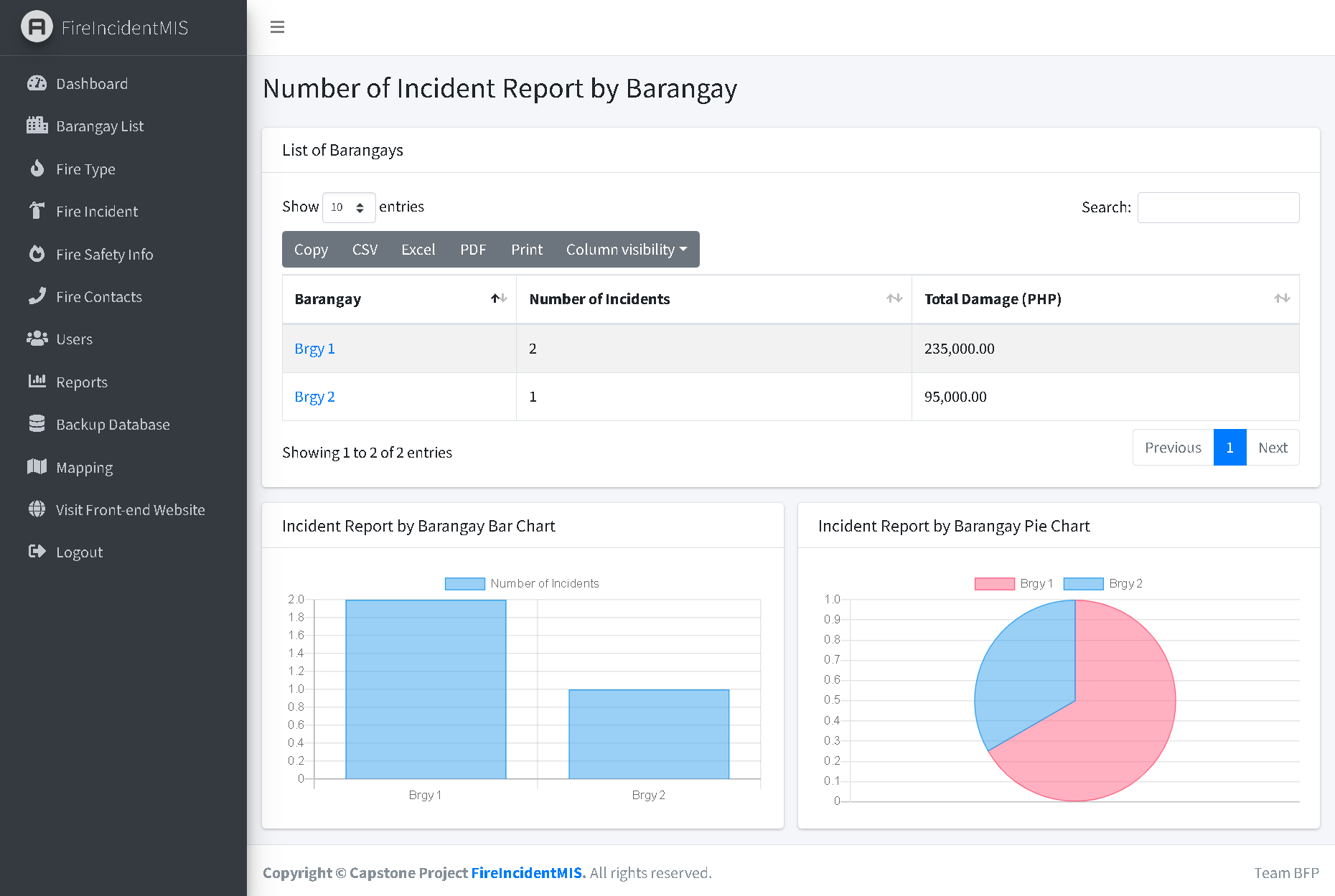Fire Incident with Mapping and Report Archiving System
Introduction
Table of Contents
Traditional fire incident reporting methods often rely heavily on paperwork, which can lead to numerous challenges. These include delays in reporting, difficulties in sharing information, and limitations in data analysis and accessibility. Physical documents are prone to being lost or damaged, and manual data entry can be time-consuming and error-prone. Additionally, the lack of a centralized database means that compiling reports and generating insights requires significant effort.
To address these challenges, we introduce the Fire Incident with Mapping and Report Archiving System. This system offers a comprehensive solution for managing fire incident reports through digital means. By leveraging modern technology, it provides several benefits:
- Efficiency: Digital reporting streamlines data entry and retrieval, reducing the time required for both.
- Accuracy: Automated data handling minimizes the risk of human error.
- Accessibility: Centralized data storage ensures that incident reports are readily available for authorized personnel, facilitating better communication and coordination.
- Analysis: Integrated mapping and reporting tools allow for sophisticated data analysis, enabling departments to identify trends and improve response strategies.
This project utilizes PHP, MySQL, and Leaflet to build the system. PHP is a robust server-side scripting language that powers dynamic web applications, making it ideal for managing data input and user interactions. MySQL provides a reliable and scalable database solution for storing incident reports, user information, and other relevant data. Leaflet, a powerful open-source JavaScript library, allows for the creation of interactive maps to visualize incident locations and details. Together, these technologies ensure a comprehensive, efficient, and user-friendly solution for fire incident management.
Project Objectives
The main goals and objectives of developing the Fire Incident with Mapping and Report Archiving System are centered around improving the efficiency, accuracy, and effectiveness of fire incident management. By digitizing the reporting and archiving processes, the system aims to provide fire departments with a comprehensive set of tools to streamline their operations.
- Efficient Incident Reporting: One of the primary objectives is to simplify and expedite the process of incident reporting. The system will enable firefighters to quickly and accurately input incident details, including location, time, severity, and other relevant information. This digital approach eliminates the need for manual paperwork, reducing the chances of errors and speeding up the reporting process.
- Centralized Report Archiving: Another objective is to create a centralized repository for incident reports. All reports will be securely stored in a database, allowing authorized personnel to easily access and retrieve information when needed. This centralization ensures that reports are not lost, misplaced, or damaged, providing a reliable and organized system for archiving.
- Interactive Mapping and Visualization: The system aims to leverage the power of mapping technology to enhance incident management. By integrating Leaflet into the system, fire departments can visualize incident locations on an interactive map. This feature enables better situational awareness, allowing for quick identification of incident hotspots, patterns, and potential response challenges.
- Data Analysis and Decision-making: The Fire Incident with Mapping and Report Archiving System seeks to empower fire departments with data analysis capabilities. By leveraging the stored incident data, the system can generate meaningful reports, statistics, and trends. This data-driven approach enables fire departments to make informed decisions, allocate resources effectively, and implement proactive measures to prevent future incidents.
System Overview
The Fire Incident with Mapping and Report Archiving System is designed to streamline the process of reporting, managing, and analyzing fire incidents. By leveraging modern technologies such as PHP, MySQL, and Leaflet, the system offers a comprehensive solution for fire departments to enhance their operational efficiency and data management capabilities.
Integration of a Map (Leaflet) to Visualize Incident Locations
One of the standout features of this system is its integration with Leaflet, an open-source JavaScript library for interactive maps. This allows users to:
- Visualize Incident Locations: Every reported fire incident is plotted on an interactive map, providing a clear and immediate geographical context. This visualization helps in identifying hotspots, patterns, and trends, which can be crucial for strategic planning and resource allocation.
- Interactive Map Features: Users can zoom in and out, click on specific incident markers to view detailed information, and filter the map view based on various criteria such as date range or incident type. This makes it easy to navigate and analyze spatial data related to fire incidents.
Storing Incident Reports in a Database (MySQL)
The system uses a MySQL database to securely store detailed incident reports. Each report includes key information such as:
- Date and Time: The precise date and time when the incident occurred.
- Location: The geographical location of the incident, which is also plotted on the map.
- Type of Incident: Categorizing the nature of the incident (e.g., residential fire, commercial fire, wildfire).
- Damage Assessment: Details about the extent of the damage caused by the fire, including property damage and any casualties.
This structured storage of data ensures that all incident reports are easily accessible, searchable, and can be backed up securely.
Functionalities for Searching and Filtering Past Incidents (Optional)
To enhance usability, the system includes powerful search and filter functionalities:
- Search by Criteria: Users can search past incidents based on various criteria such as date range, location, type of incident, and severity of damage. This makes it easy to retrieve specific reports from the database.
- Filter Options: Advanced filtering options allow users to narrow down incident reports to those that meet certain conditions, aiding in quick and efficient data retrieval.
Options for Generating Reports with Incident Data and Location Visualizations (Optional)
For comprehensive analysis and reporting, the system provides tools to generate detailed reports:
- Incident Data Reports: Users can generate reports that compile data from multiple incidents, providing insights into trends and patterns over time. These reports can be used for internal reviews, public reports, or strategic planning.
- Location Visualizations: Reports can include visual elements such as maps with incident locations marked, charts showing incident frequency, and graphs depicting damage assessments. These visualizations make the data more understandable and actionable.
- Customizable Report Formats: Users have the option to customize the format and content of the reports, ensuring they meet the specific needs of different stakeholders.
By integrating these features, the Fire Incident with Mapping and Report Archiving System provides a robust platform for fire departments to manage and analyze incident data effectively. The combination of interactive maps, secure data storage, advanced search and filter options, and comprehensive reporting capabilities ensures that fire departments can improve their operational efficiency, enhance public safety, and make data-driven decisions.
System Development
The development of the Fire Incident with Mapping and Report Archiving System involves a combination of front-end, back-end, and mapping technologies to create a comprehensive and user-friendly application. Here’s a brief overview of the development process:
Front-End Development Using Bootstrap
Bootstrap, a popular open-source front-end framework, is utilized to design and build the user interface (UI) of the system. The benefits and key aspects of using Bootstrap include:
- Responsive Design: Bootstrap ensures that the system’s interface is responsive and works seamlessly across various devices, including desktops, tablets, and smartphones. This is crucial for users who may need to access the system on the go.
- Pre-designed Components: Bootstrap provides a range of pre-designed components such as forms, buttons, navigation bars, and alerts. These components help in creating a consistent and visually appealing interface quickly.
- Customization: The framework allows for extensive customization to match the specific needs and branding of the fire department. Custom CSS can be added to fine-tune the appearance and behavior of the interface elements.
Back-End Development Using PHP
PHP is used for the back-end development of the system, handling data processing and server-side logic. The key roles of PHP in this system include:
- Data Processing: PHP scripts process user inputs, such as incident reports, and interact with the MySQL database to store and retrieve data. This includes handling form submissions, validation, and data sanitization to ensure the integrity and security of the data.
- Database Interaction: PHP provides the necessary functions to connect to the MySQL database, perform queries, and manage the data. This includes inserting new incident reports, updating existing records, and retrieving data for display on the front-end.
- Session Management: PHP manages user sessions, ensuring that only authenticated users can access certain features of the system. This helps in maintaining data security and user-specific functionalities.
Leaflet Integration for Displaying an Interactive Map
Leaflet, an open-source JavaScript library for interactive maps, is integrated into the system to visualize the locations of fire incidents. The integration process includes:
- Map Initialization: Leaflet is used to initialize the map on the web page, setting the initial view (center and zoom level) based on the geographical area covered by the fire department.
- Adding Markers: Incident location markers are dynamically added to the map based on the data retrieved from the MySQL database. Each marker represents a fire incident and includes relevant details such as the incident type, date, and damage assessment.
- Interactive Features: The map is enhanced with interactive features such as zooming, panning, and clicking on markers to view detailed information about each incident. These features improve user engagement and make it easier to analyze incident data spatially.
- Customization: Leaflet allows for extensive customization of the map’s appearance and behavior, including custom marker icons, pop-ups, and layer controls. This ensures the map is tailored to the specific needs of the fire department.
By integrating these technologies, the development process ensures that the system is robust, user-friendly, and efficient. The combination of a responsive front-end, a powerful back-end, and an interactive map provides a comprehensive solution for managing and analyzing fire incidents.
Benefits and Advantages
The Fire Incident with Mapping and Report Archiving System offers several benefits and advantages that significantly improve fire incident management practices. Here are the key advantages of the system:
- Improved Efficiency: The system streamlines the incident reporting process, eliminating the need for manual paperwork. Firefighters can quickly input incident details into the system, saving time and reducing administrative burdens. This improved efficiency allows firefighters to focus more on emergency response and critical tasks.
- Enhanced Data Analysis: The integration of an interactive map using Leaflet enables fire departments to visualize incident locations. This visualization provides valuable insights into incident trends and patterns, allowing for better analysis and understanding of fire incidents. By identifying hotspots and patterns, fire departments can make informed decisions and implement targeted prevention strategies
- Improved Decision Making: The system empowers fire departments with data-driven insights. By analyzing incident data and visualizing it on the map, fire departments can identify high-risk areas, assess the effectiveness of current strategies, and allocate resources more effectively. This data-driven decision-making approach enhances incident response strategies and improves overall emergency management practices.
- Streamlined Information Sharing: The system provides easy access to incident reports for firefighters and other stakeholders. Authorized personnel can retrieve incident reports from the database, ensuring seamless information sharing and collaboration among team members. This streamlined access to information enhances communication, coordination, and situational awareness during incident response.
In essence, the Fire Incident with Mapping and Reporting Archiving System empowers fire departments to move beyond reactive firefighting and embrace a proactive approach. By leveraging data and technology, this system equips fire departments with the tools to make informed decisions, ultimately leading to a safer and more fire-resilient community.
Project Demo – bookmark this page for updates

Conclusion
In conclusion, the Fire Incident with Mapping and Report Archiving System aims to modernize and streamline the process of reporting and analyzing fire incidents. By integrating technologies such as PHP, MySQL, and Leaflet, the system enhances the efficiency of data entry and retrieval, enables sophisticated data analysis through interactive mapping, and supports informed decision-making with comprehensive reports and visualizations. These achievements underscore the project’s primary objectives: improving the efficiency of fire incident management, enhancing data analysis capabilities, and facilitating better decision-making and resource allocation.
The importance of digital solutions in emergency management cannot be overstated. Traditional methods, reliant on paperwork and manual processes, are increasingly insufficient in handling the complexity and volume of data required for effective fire incident management. Digital systems provide faster, more accurate, and more comprehensive ways to manage information, ensuring that fire departments can respond more swiftly and effectively to emergencies. The integration of mapping and data visualization tools further enriches the analytical capabilities, allowing for proactive and informed strategies in fire prevention and resource distribution.
As we look to the future, it is essential to encourage further exploration and implementation of similar systems in various areas of emergency management. The benefits of digitization are clear, and extending these solutions to other aspects of emergency response and public safety can lead to even greater improvements in efficiency, effectiveness, and overall safety. Fire departments and other emergency management organizations are urged to consider adopting such systems to enhance their operations and better serve their communities.
Readers are also interested in:
- 30 Best Web Development Project Ideas
- 40 List of DBMS Project Topics and Ideas
- List of 45 IT Capstone Project on Crime and Disaster Management
- PHP MySQL and Bootstrap Capstone Projects
You may visit our Facebook page for more information, inquiries, and comments. Please subscribe also to our YouTube Channel to receive free capstone projects resources and computer programming tutorials.
Hire our team to do the project.


